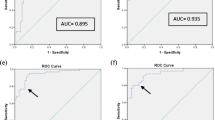Abstract
The aim of this study was to find the correlation between serum p53 and carcinoma of the bladder and to investigate whether serum p53 protein can be used as a tumor marker for p53 gene alteration. The study included patients with carcinoma of the bladder and controls. Serum p53 protein estimation was done with an ELISA kit. There were 23 patients with superficial and 17 with invasive carcinoma. The median serum p53 was 31.5 U/ml in superficial and 41 U/ml in invasive cancer. This was significantly higher than the mean value (16.4 U/ml) of controls. Serum p53 rises in patients with carcinoma of the bladder and correlates with the grade of the disease .It can therefore be used as a tumor marker for bladder cancer.

Similar content being viewed by others
References
Brandau S, Bohle A (2001) Bladder cancer. I. Molecular and genetic basis of carcinogenesis. Eur Urol 39: 491
Dahse R, Utting M, Werner W, Schimmel B, Claussen U, Junker K (2002) TP53 alterations as a potential diagnostic marker in superficial bladder carcinoma and in patients serum, plasma and urine samples. Int J Oncol 20: 107
Krajewska B, Lutz W, Pilacik B (1998) Determination of blood serum oncoprotein NEU and antioncoprotein p53—molecular biomarkers in various types of occupational exposure. Int J Occup Med Environ Health 11: 343
Schmitz-Drager BJ, Goebell PJ, Ebert T, Fradet Y (2000) P53 immunohistochemistry as a prognostic marker in bladder cancer. Playground for urology scientists? Eur Urol 38: 691
Finlay CA, Hinds PW, Tan TH (1988) Activating mutations for the transformation by p53 produce a gene product that forms an hsc-p53 complex with an altered half life. Mol Cell Biol 8: 531
Fontanini G, Fiore L, Bigini D, Vignati S, Calvo S, Mussi A, Lucchi M, Anggeletti CA, Merlo GR, Basolo F (1994) Levels of p53 antigen in the serum of non small cell lung cancer patients correlate with positive p53 immunohistochemistry on tumor sections, tumor necrosis and nodal involvement. Int J Oncol 5: 553
Chow V, Yuen APW, Lam KY, Ho WK, Wei WI (2001) Prognostic significance of serum p53 protein and p53 antibody in patients with surgical treatment for head and neck squamous cell carcinoma. Head Neck 23: 286
Luo JC, Neugut AI, Garbowski G, Forde KA, Treat M, Smith S, Carney WP, Brandt-Rauf PW (1995) Levels of p53 antigen in the plasma of patients with adenomas and carcinomas of the colon. Cancer Lett 91: 235
Suwa H, Ohshio G, Okada N, Wang Z, Fukumoto M, Imamura T, Imamura M (1997) Clinical significance of serum p53 antigen in patients with pancreatic carcinomas. Gut 40: 647
Friedrich MG, Riethdorf S, Erbersdobler A, Tiemer C, Schwaibold H, Solter JK, Huland E, Riethdorf L, Conrad S, Hammerer PG, Huland H (2001) Relevance of p53 gene alterations for tumor recurrence in patients with superficial transitional cell carcinoma of the bladder. Eur Urol 39: 159
Lipponen PK (1993) Overexpression of p53 nuclear oncoproteins in transitional cell bladder cancer and its prognostic value. Int J Cancer 53: 365
Esrig D, Elmajian D, Groshen S, Freman JA, Stein JP, Chen SC, Nichols PW, Skinner DJ, Jones PA, Cote RJ (1994) Accumulation of nuclear p53 and tumor progression in bladder cancer. N Eng J Med 331: 1259
Jahnsons S, Risberg B, KarlssonMG, Westman G, Bergstorm R, Pedersen J (1995) p53 and Rb immunostaining in locally advanced bladder cancer: relation to prognostic variables and predictive value for the local response to radical radiotherapy. Eur Urol 28: 135
Lu ML, Wikman F, Orntoft TF, Charytonowicz E, Rabbani F, Zhang Z, Dalbagni G, Pohar KS, Yu G, Cordon-Cardo C (2002) Impact of alterations affecting the p53 pathway in bladder cancer on clinical outcome, assessed by conventional and array-based methods. Clin Cancer Res 8: 171
Schmitz-Drager BJ, Goebell PJ, Ebert T, Fradet Y (2000) p53 immunohistochemistry as a prognostic marker in bladder cancer. Playground for urology scientists? Eur Urol 38: 691
Morita T, Tachikawa N, Kumamaru T, Nukui A, Ikeda H, Suzuki K, Tokue A (2000) Serum anti-p53 antibodies and p53 protein status in the sera and tumors from bladder. Cancer patients. Eur Urol 37: 79
Author information
Authors and Affiliations
Corresponding author
Rights and permissions
About this article
Cite this article
Malviya, V., Singh, H., Dwivedi, U.S. et al. Serum p53 and bladder cancer: can serum p53 be used as a tumor marker?. Urol Res 32, 391–394 (2004). https://doi.org/10.1007/s00240-004-0415-9
Received:
Accepted:
Published:
Issue Date:
DOI: https://doi.org/10.1007/s00240-004-0415-9




